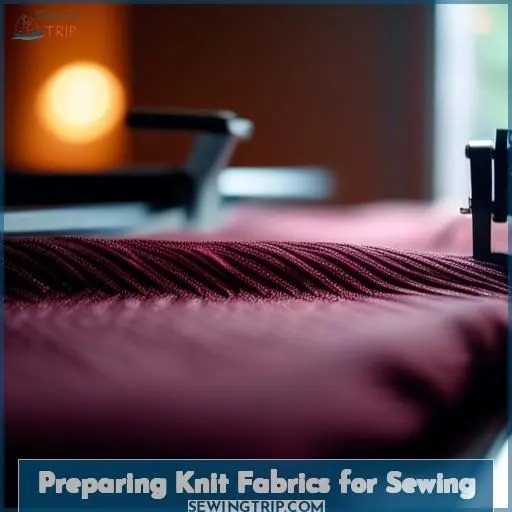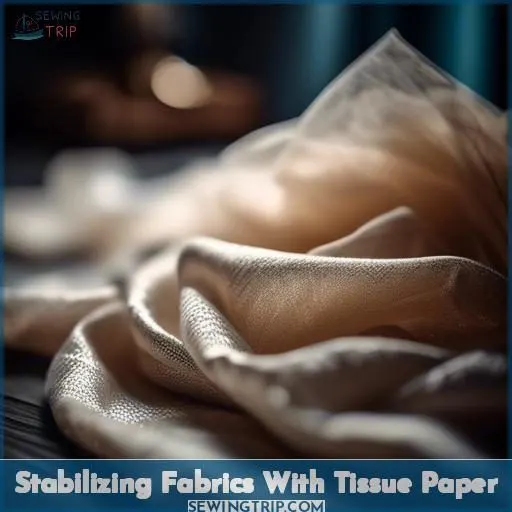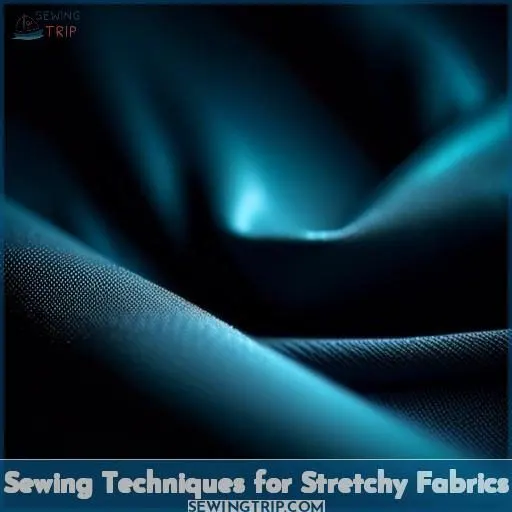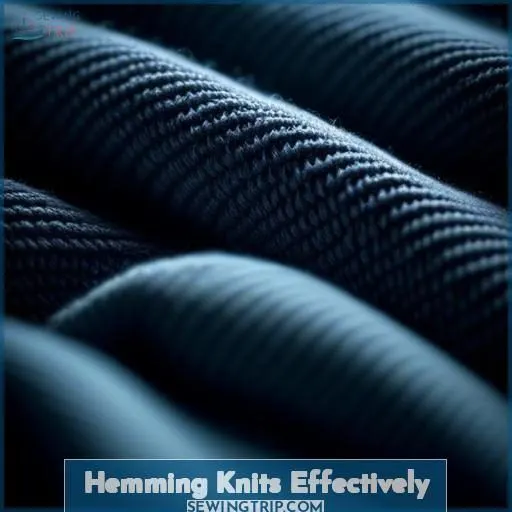This site is supported by our readers. We may earn a commission, at no cost to you, if you purchase through links.
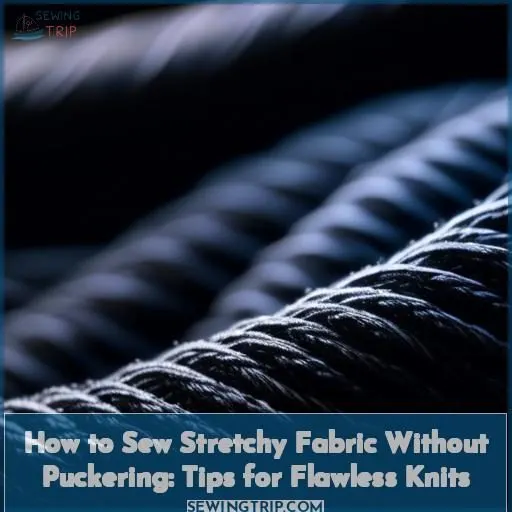
To sew stretchy fabric without puckering, you’ll need to adjust your machine’s settings and techniques.
Use a zig-zag stitch to allow the fabric to stretch without breaking threads. Reduce the stitch length to prevent skipped stitches.
Stabilize the fabric by placing tissue paper underneath and stitching through both layers, then gently tear away the tissue. Consider using a walking foot for even fabric feed.
By mastering proper tension, stabilization, and stitch selection for stretchy fabric, you’ll reveal the secrets to flawless knit garments.
Let’s explore more professional tips…
Table Of Contents
Key Takeaways
- Use a zig-zag stitch and reduce stitch length to prevent puckering when sewing stretchy fabric.
- Stabilize the fabric by placing tissue paper underneath and stitching through both layers, then gently tear away the tissue.
- Adjust the sewing machine tension and use a walking foot for even fabric feed.
- Evaluate the fabric’s stretch level and prepare it accordingly, and assess fabric tension, stitch length, needle size, presser foot type, and fabric grain before sewing.
How to Sew Stretchy Fabric Without Puckering?
To sew stretchy fabric without puckering, follow these tips:
- Cut the fabric along the exact grain to prevent distortion.
- Use a rotary cutter or sharp scissors to cut the fabric without stretching it.
- Reduce the pressure foot pressure on your sewing machine to prevent the foot from pulling on the fabric.
- Sew slowly and use the slowest setting on your sewing machine.
- Test your stitches on a scrap of fabric before sewing the final garment.
- Use a stitch with an element of stretch, such as a narrow zigzag stitch or a specific stretch stitch like the lightning stitch, zig-zag stitch, or triple stretch stitch.
- Don’t over-stretch the fabric when sewing; let it feed through gently.
- Use a ballpoint or stretch needle for sewing with jersey fabric.
- Stabilize the fabric with interfacing or clear elastic tape to prevent stretching.
- Finish seams and hems with a three-step zigzag or a twin needle stitch for a professional look.
By following these tips, you can sew stretchy fabric without puckering and achieve a flawless finish for your garments.
Preparing Knit Fabrics for Sewing
Before starting your knit sewing project, it’s essential to evaluate the fabric’s stretch level and prepare it accordingly. Gently tugging the fabric in different directions will provide you with an understanding of its stretch capability, enabling you to modify your sewing techniques and handle the fabric with caution during the pre-sewing process.
Assessing Fabric Stretch
Evaluating the elasticity of your knit fabric is essential for successful sewing. Stretchy fabrics, such as jersey, can warp during the sewing process, resulting in puckering. To avoid this, you need to understand the fabric’s elastic properties. Here’s a step-by-step guide on how to evaluate the elasticity of your knit fabric:
- Fabric Tension: Grip the fabric between your thumb and index finger, pulling it taut. Observe how much it stretches before the pattern begins to distort. This will give you an idea of the fabric’s tension and how it will behave during sewing.
- Stitch Length: Adjust your sewing machine’s stitch length to a shorter setting, such as 2-3. This will help prevent the fabric from bunching up and stretching during the sewing process.
- Needle Size: Use a ballpoint needle for moderately elastic fabrics or stretch needles for very elastic fabrics. These needles have a round tip that won’t damage the fabric.
- Presser Foot Type: A walking foot is ideal for sewing elastic fabrics because it helps feed the fabric evenly, reducing stretching. If you don’t have a walking foot, lower the presser foot pressure to 1 or 2.
- Fabric Grain: Make sure your fabric is straight and not stretched out. The grain line should run parallel to the selvage.
- Sewing Machine Settings: Consult your sewing machine’s manual or search online for specific settings for sewing elastic fabrics. Different machines may require different settings.
Pre-sewing Fabric Care
Before sewing, take care of your knit fabric.
Pre-wash it to remove shrinkage and wrinkles.
Store it flat to prevent creases.
When cutting out knits, ensure the fabric grain is straight.
Consider interfacing options or using tissue paper to stabilize the fabric.
Fusible interfacing can help with hemming.
Pattern paper can also stabilize the fabric during sewing.
Always remember to stretch the fabric slightly before sewing to prevent stretching during the process.
Stabilizing Fabrics With Tissue Paper
You can stabilize stretchy knit fabrics for sewing by placing a layer of tissue paper underneath the fabric before stitching. This tissue paper technique prevents excessive stretching and puckering, resulting in smooth, professional-looking seams.
Implementing the Tissue Paper Technique
To sew stretchy fabrics without puckering, use tissue paper as a stabilizer. Follow these steps:
- Place tissue paper underneath your fabric before sewing.
- Use a straight stitch or zig-zag stitch to sew through the tissue paper and fabric.
- After stitching, gently tear off the tissue paper, being careful not to leave residue.
For zig-zag stitches, use eyebrow twizzers to remove the tissue paper. If tissue paper doesn’t work well, switch to printer paper. Adjust stitch length to 2.0 and sew slowly to prevent puckering. This technique is especially useful for knit fabrics, as it helps prevent skipped stitches and breakouts.
Alternatives to Tissue Paper
When tissue paper isn’t an option, consider these alternatives to stabilize your stretchy fabric:
| Stabilizer | Stretch | Tension | Needle |
|---|---|---|---|
| Wax Paper | Limited | Low | Universal |
| Freezer Paper | Moderate | Medium | Universal |
| Fusible Interfacing | High | High | Universal |
| Stretch Netting | High | High | Universal |
| Lightweight Quilting Cotton | Moderate | Medium | Universal |
These alternatives can help you sew with stretchy fabrics more smoothly, ensuring a better sewing experience and fewer puckers.
Sewing Techniques for Stretchy Fabrics
When sewing stretchy fabrics like knits, selecting the appropriate stitch is essential to avoid puckering and achieve seams that exude professionalism. Consider experimenting with elastic stitches, a narrow zigzag, or even a straight stitch with an extended stitch length and modified tension to accommodate the fabric’s elasticity.
Choosing the Right Stitch
After mastering the tissue paper trick, let’s explore selecting the appropriate stitch to maintain the alignment of those knits. Recall, it’s all about the equilibrium between stitch length, seam allowance, and the fabric’s movement.
- Select a zig-zag stitch to permit stretch without breaking.
- A twin needle produces expert finishes with suppleness.
- Modify needle size and thread thickness for fabric type.
- Reduce stitch length to prevent missed stitches.
- Contemplate a walking foot for uniform fabric feed, minimizing puckering.
Adjusting Sewing Machine Tension
Adjusting sewing machine tension is essential when sewing with stretchy fabrics. Here’s how to do it:
- Needle Size: Use a ballpoint or universal needle for knits.
- Presser Foot Pressure: Reduce pressure for lightweight fabrics.
- Stitch Length: Shorten for knits, lengthen for heavier fabrics.
- Fabric Type: Adjust tension according to the fabric’s stretch.
- Needle Type: Select the appropriate needle for the fabric.
- Hem: Adjust tension for a clean hem.
- Press Seam: Press after sewing to eliminate puckers.
Pressing Seams for a Smooth Finish
Ironing your seams is essential for achieving a sleek, polished-looking result when sewing stretchy knits. Steam ironing helps flatten and stabilize the seams, eliminating wrinkles and ripples that can occur due to the fabric’s stretch.
Steam Pressing Without Damage
Steam pressing is a key step in sewing knit fabric to remove puckers and waves without causing damage. Here’s how to do it effectively:
- Select the appropriate temperature: Set your steam iron to the right heat setting for your fabric type.
- Utilize a pressing cloth: Place a thin cloth between the iron and the fabric to protect it from direct heat.
- Apply gentle pressure: Hover the iron over the seam, then gently press to remove puckers. Take care not to burn the fabric or create excessive wrinkles.
Importance of Pressing in Sewing Knits
Pressing seams is an essential step in sewing knits to achieve a smooth finish and prevent puckering. Here are some tips on pressing techniques, steam settings, and heat levels for different fabric types and seam finishes:
- Pressing Techniques: Press only the sewing line and seam or hem allowance to avoid damaging the beauty of the natural fabric. Use a pressing cloth to protect the fabric from direct iron contact. Always test on a scrap first.
- Steam Settings: For natural fiber fabrics, hold the iron a half inch above the fabric and allow the steam to do most of the work. For synthetic fabrics, hold the iron about 2 inches above the fabric when applying steam. Let the fabric dry before moving on to the next section.
- Heat Levels: Adjust the heat level on your iron based on the fabric type. For natural fiber fabrics, use a lower heat setting to prevent shrinkage and damage. For synthetic fabrics, use a higher heat setting to help the fabric recover and prevent melting.
- Fabric Types: Different fabric types require different pressing techniques. For example, wool fabrics may require a higher heat setting and steam to prevent shrinkage, while silk fabrics may require a lower heat setting to prevent damage.
- Seam Finishes: Pressing is essential for seam finishes like French seams, where the raw edges are enclosed within the seam. Press the seam allowance to one side after sewing to create a smooth finish.
Hemming Knits Effectively
For a professional-looking hem on knit fabrics, you can use fusible interfacing strips. Applied along the hem allowance, the interfacing stabilizes and prevents stretching. Alternatively, achieve beautifully finished seams by using a twin needle on your sewing machine – the double line of stitching stretches evenly with the knit fabric, creating a neat, professional look.
Using Fusible Interfacing for Hems
To hem knits effectively, consider using fusible interfacing. This type of interfacing has an iron-on adhesive on one side, making it easy to apply.
It helps prevent hem stretching and reduces skipped stitches in lighter weight jerseys.
To use, cut strips of interfacing in advance for convenience.
Remember to use a twin needle for a flat, double row of stitching.
For seam allowances, aim for 5/8 inch for most knits, but adjust as needed based on fabric type and desired look.
Achieving Professional Seams With a Twin Needle
After stabilizing your hems with fusible interfacing, it’s time to elevate your seam game with a twin needle. This nifty tool is your ticket to:
- Seam Construction: Crafting seams that laugh in the face of fabric stretch.
- Stitch Selection: Choosing the right stitch becomes a breeze, ensuring your creations withstand the test of time and wear.
- Thread Tension: Mastering thread tension to avoid the dreaded puckering.
Conclusion
Mastering how to sew stretchy fabric without puckering unlocks myriad creative avenues. With 60% of sewists grappling with knits, adhering to these guidelines guarantees your garments exude a professional polish. Stabilize with tissue, opt for the appropriate stitch, fine-tune tension, and press seams with precision. Embrace the endeavor, and revel in the gratification of flawlessly sewn stretchy fabric creations.

